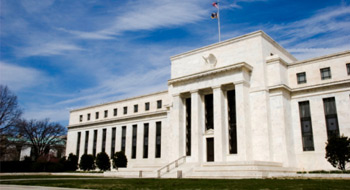
Following the Federal Reserve’s monetary policy meeting Wednesday, the Federal Open Market Committee announced it plans to stand pat on interest rates for the time being.
According to the FOMC’s latest release, “the Committee today reaffirmed its view that the current 0% to 0.25% target range for the federal funds rate remains appropriate. In determining how long to maintain this target range, the Committee will assess progress (both realized and expected) toward its objectives of maximum employment and 2% inflation.”
Read: Experts split on rate cut’s impact
The FOMC says it’s holding on raising rates because while “growth in household spending has been moderate, and the housing sector has shown additional improvement, […] business fixed investment and net exports stayed soft.”
On the bright side, it adds, “The labor market [has] continued to improve, with solid job gains and declining unemployment.”
Still, it says inflation has been below-target due to decreasing energy prices and non-energy import prices. “Market-based measures of inflation compensation [also] remain low, [while] survey‑based measures of longer-term inflation expectations have remained stable.”
Read: The hunt for liquidity continues
In addition, the FOMC is concerned about the strength of the global economy, and how markets will react to a rise in rates. As such, “The Committee currently anticipates that, even after employment and inflation are near mandate-consistent levels, economic conditions may, for some time, warrant keeping the target federal funds rate below levels the Committee views as normal in the longer run.”
Market commentary
Avery Shenfeld, chief economist for CIBC World Markets, says the FOMC’s announcement should come as no surprise. “Nobody expected a rate hike today,” he says in a release, “and nobody should have expected the Fed to pre-commit to anything for September, with weeks of data still to get through. As a result, today’s essentially stand-pat statement, with few changes from June, is not particularly revealing.”
But, he adds, the FOMC does say that “underuse of labour has ‘diminished,’ rather than ‘somewhat diminished.’ [And] they dropped a reference to energy prices having stabilized, [and that] they now only need ‘some further improvement,’ rather than just ‘further improvement’ in the job market to tighten.”
Prior to the FOMC’s release of its meeting minutes, Associated Press reported many economists foresee the first hike coming in September. But these experts didn’t expect this week’s policy statement to clearly signal the timing. Federal Reserve chair Janet Yellen has stressed in past months that the decision will be driven by the latest economic data, and that the Fed still wants to keep its options open.
Read: Betting against Treasuries? Think again….
In a speech to Congress earlier this month, Yellen said, “Our economy is in a much better state. We’re close to where we want to be, and we now think the economy can not only tolerate but needs higher rates.”
But the economy still faces an array of threats, including subpar U.S. manufacturing performance, and low business investment. Also, troubles in Europe and Asia have roiled financial markets.
Going forward, Yellen is set to hold a news conference following the Fed’s September meeting, which is why experts say it’s the most likely time for a rate increase. Others think the Fed might wait until December.
“The recent volatility in the global economy and financial markets has given the Fed pause,” says Sung Won Sohn, an economics professor at the Martin Smith School of Business at California State University, Channel Islands. “I think the probability of a rate hike in September has diminished because the Fed is going to need more time to evaluate how the U.S. economy is doing. December looks like a good possibility.”
However, economists who think the Fed will act in September point not only to low unemployment, but also to signs of strength in such areas as housing and consumer spending. “The economy has a lot of momentum, and if you don’t start raising rates off zero, then it will be hard to curtail that momentum and inflation will become a problem down the road,” says Mark Zandi, chief economist at Moody’s Analytics.
There’s also some concern that prolonged ultra-low rates may have begun to inflate dangerous bubbles in stocks, bonds or other assets.
Read: Money managers bullish on equities, alternatives
Still, concern about igniting an overreaction in financial markets is a key reason economists think the Fed will show extreme caution in raising rates, whatever their decision—stocks and bonds suffered sharp declines in 2013 after the Fed initially mishandled its communications about when it would begin slowing its bond purchase program.
“The situation could be volatile,” says Diane Swonk, chief economist at Mesirow Financial. “The Fed is going to raise rates once, most likely in September, and then wait for some time before raising them again to judge market reaction.”
This story originally appeared on our sister site, Advisor.ca.
